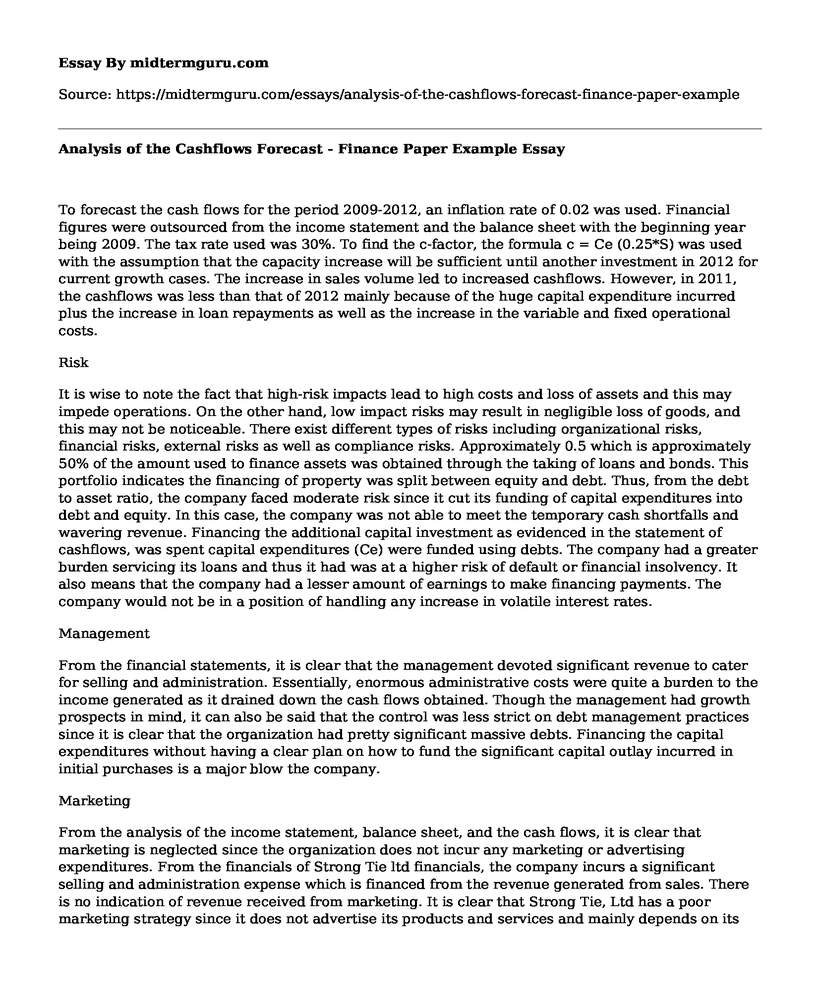To forecast the cash flows for the period 2009-2012, an inflation rate of 0.02 was used. Financial figures were outsourced from the income statement and the balance sheet with the beginning year being 2009. The tax rate used was 30%. To find the c-factor, the formula c = Ce (0.25*S) was used with the assumption that the capacity increase will be sufficient until another investment in 2012 for current growth cases. The increase in sales volume led to increased cashflows. However, in 2011, the cashflows was less than that of 2012 mainly because of the huge capital expenditure incurred plus the increase in loan repayments as well as the increase in the variable and fixed operational costs.
Risk
It is wise to note the fact that high-risk impacts lead to high costs and loss of assets and this may impede operations. On the other hand, low impact risks may result in negligible loss of goods, and this may not be noticeable. There exist different types of risks including organizational risks, financial risks, external risks as well as compliance risks. Approximately 0.5 which is approximately 50% of the amount used to finance assets was obtained through the taking of loans and bonds. This portfolio indicates the financing of property was split between equity and debt. Thus, from the debt to asset ratio, the company faced moderate risk since it cut its funding of capital expenditures into debt and equity. In this case, the company was not able to meet the temporary cash shortfalls and wavering revenue. Financing the additional capital investment as evidenced in the statement of cashflows, was spent capital expenditures (Ce) were funded using debts. The company had a greater burden servicing its loans and thus it had was at a higher risk of default or financial insolvency. It also means that the company had a lesser amount of earnings to make financing payments. The company would not be in a position of handling any increase in volatile interest rates.
Management
From the financial statements, it is clear that the management devoted significant revenue to cater for selling and administration. Essentially, enormous administrative costs were quite a burden to the income generated as it drained down the cash flows obtained. Though the management had growth prospects in mind, it can also be said that the control was less strict on debt management practices since it is clear that the organization had pretty significant massive debts. Financing the capital expenditures without having a clear plan on how to fund the significant capital outlay incurred in initial purchases is a major blow the company.
Marketing
From the analysis of the income statement, balance sheet, and the cash flows, it is clear that marketing is neglected since the organization does not incur any marketing or advertising expenditures. From the financials of Strong Tie ltd financials, the company incurs a significant selling and administration expense which is financed from the revenue generated from sales. There is no indication of revenue received from marketing. It is clear that Strong Tie, Ltd has a poor marketing strategy since it does not advertise its products and services and mainly depends on its current market and customer base for sales. Essentially, the company is at risk of receiving negative cashflows especially when economic swings occur or when a competitor may differentiate its products and services and take a significant market share. The fluctuation in the revenue generated by the company can be attributed to the wavering demand of Strongs limited market. Ideally, this is a shortcoming of the company since it restricts potential in acquiring new markets obtained through marketing.
Recommendation
It is hard to implement business-appropriate security controls without a clear understanding of how much risk and what kind of risk the enterprise is willing to take. From the analysis, it is clear that the risk level of the company ranges from moderate to high. Curbing risks requires that Strong Ties Ltd to consider using adequate controls in taking out shares and in financing operations. The high debt level in the business may negatively impact a companys ability to secure additional financing when needed. Moreover, Strong-Tie Ltd should also review and monitor the performance of the enterprise to ensure that the operations run by the company are efficient and that the investments made by the company generate sufficient revenue to pay off the debts and ensure growth and sustainability of the business in the long run. It is a high time that the Strong-Tie Ltd adopts effective marketing strategies and reach out to the target market to increase its customer base. While in the pursuit of adopting a suitable marketing strategy, Strong Tie Ltd should come up with suitable marketing plan governed by its marketing mix. It should define its products, price, place (location) as well as promotion. Moreover, it should come up with a unique selling proposition USP which will help at setting the price of the products and services it offers. There is need to devote effort in researching of what exactly the market needs and gear itself towards meeting the needs of the customers.
Cite this page
Analysis of the Cashflows Forecast - Finance Paper Example. (2021, Jun 11). Retrieved from https://midtermguru.com/essays/analysis-of-the-cashflows-forecast-finance-paper-example
If you are the original author of this essay and no longer wish to have it published on the midtermguru.com website, please click below to request its removal:
- The 2016 Republican Platform - Paper Example
- Rationale for Selecting Apple Stock - Paper Example
- Volkswagens Issue a Convertible Bond - Paper Example
- Target Acquisition Firms and Financial Performance of BCB Berhad and IWCITY Berhad - Paper Example
- Admission Essay: Finance and Investment
- Compare and Contrast Essay Sample on Tax Abatement Vs. Tax Increment Financing
- Research Paper on Classical Exchange-Traded Funds







